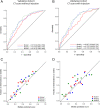Development and external validation of a prediction model for the transition from mild to moderate or severe form of COVID-19
- PMID: 37405504
- PMCID: PMC10667132
- DOI: 10.1007/s00330-023-09759-x
Development and external validation of a prediction model for the transition from mild to moderate or severe form of COVID-19
Abstract
Objectives: COVID-19 pandemic seems to be under control. However, despite the vaccines, 5 to 10% of the patients with mild disease develop moderate to critical forms with potential lethal evolution. In addition to assess lung infection spread, chest CT helps to detect complications. Developing a prediction model to identify at-risk patients of worsening from mild COVID-19 combining simple clinical and biological parameters with qualitative or quantitative data using CT would be relevant to organizing optimal patient management.
Methods: Four French hospitals were used for model training and internal validation. External validation was conducted in two independent hospitals. We used easy-to-obtain clinical (age, gender, smoking, symptoms' onset, cardiovascular comorbidities, diabetes, chronic respiratory diseases, immunosuppression) and biological parameters (lymphocytes, CRP) with qualitative or quantitative data (including radiomics) from the initial CT in mild COVID-19 patients.
Results: Qualitative CT scan with clinical and biological parameters can predict which patients with an initial mild presentation would develop a moderate to critical form of COVID-19, with a c-index of 0.70 (95% CI 0.63; 0.77). CT scan quantification improved the performance of the prediction up to 0.73 (95% CI 0.67; 0.79) and radiomics up to 0.77 (95% CI 0.71; 0.83). Results were similar in both validation cohorts, considering CT scans with or without injection.
Conclusion: Adding CT scan quantification or radiomics to simple clinical and biological parameters can better predict which patients with an initial mild COVID-19 would worsen than qualitative analyses alone. This tool could help to the fair use of healthcare resources and to screen patients for potential new drugs to prevent a pejorative evolution of COVID-19.
Clinical trial registration: NCT04481620.
Clinical relevance statement: CT scan quantification or radiomics analysis is superior to qualitative analysis, when used with simple clinical and biological parameters, to determine which patients with an initial mild presentation of COVID-19 would worsen to a moderate to critical form.
Key points: • Qualitative CT scan analyses with simple clinical and biological parameters can predict which patients with an initial mild COVID-19 and respiratory symptoms would worsen with a c-index of 0.70. • Adding CT scan quantification improves the performance of the clinical prediction model to an AUC of 0.73. • Radiomics analyses slightly improve the performance of the model to a c-index of 0.77.
Keywords: Artificial intelligence; COVID-19; Clinical decision rules; Tomography, X-ray computed.
© 2023. The Author(s).
Conflict of interest statement
M. Zysman receives payment or honoraria for lectures, presentations, speakers bureaus, manuscript writing, or educational events from CSL Behring, GSK, Boeringer Ingelheim, and AstraZeneca. M. Zysman receives support for attending meetings and/or travel from Chiesi and AstraZeneca. The remaining authors of this manuscript declare no relationships with any companies, whose products or services may be related to the subject matter of the article.
Figures


References
-
- Menéndez R, Méndez R, González-Jiménez P, et al. Early recognition of low-risk SARS-CoV-2 pneumonia: a model validated with initial data and infectious diseases Society of America/American Thoracic Society Minor Criteria. Chest. 2022;162:768–781. doi: 10.1016/j.chest.2022.05.013. - DOI - PMC - PubMed
MeSH terms
Associated data
LinkOut - more resources
Full Text Sources
Medical
Research Materials
Miscellaneous

